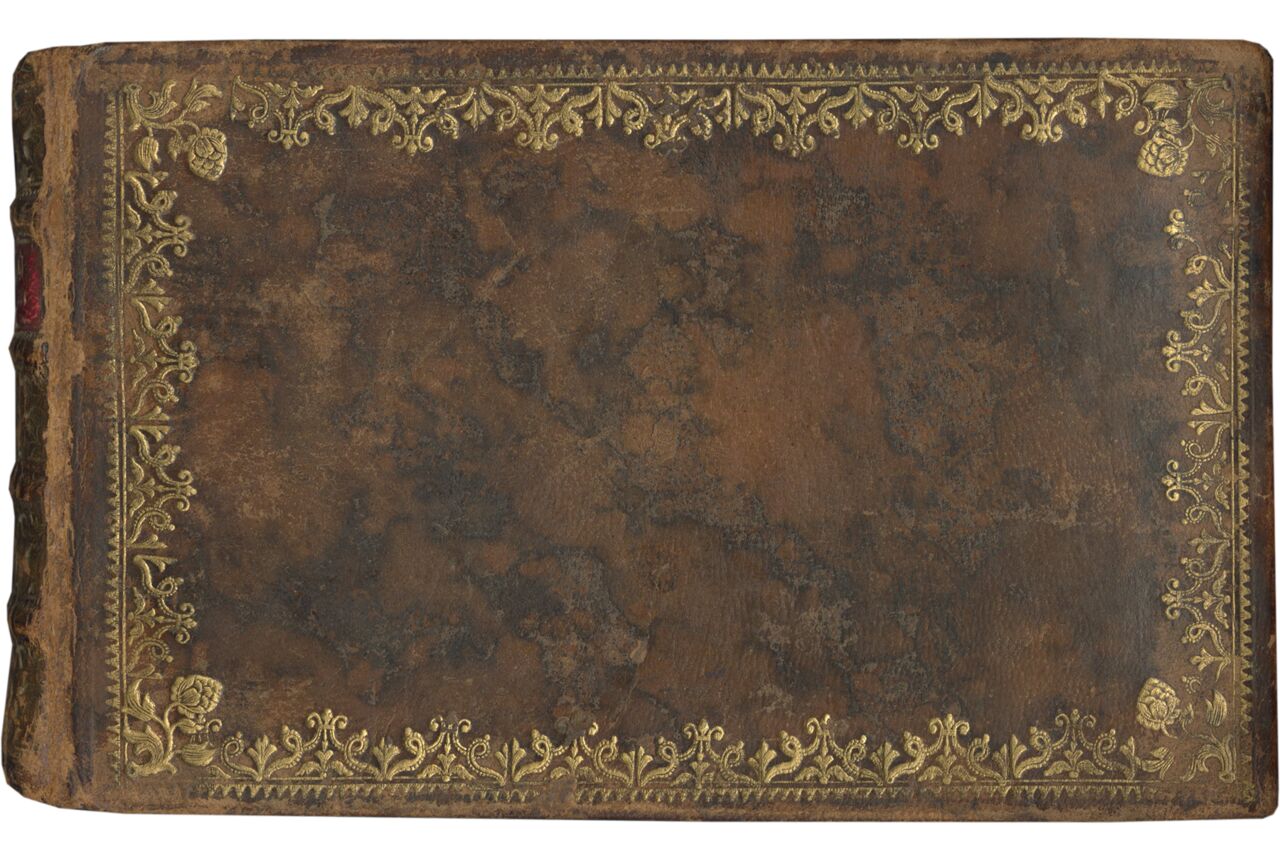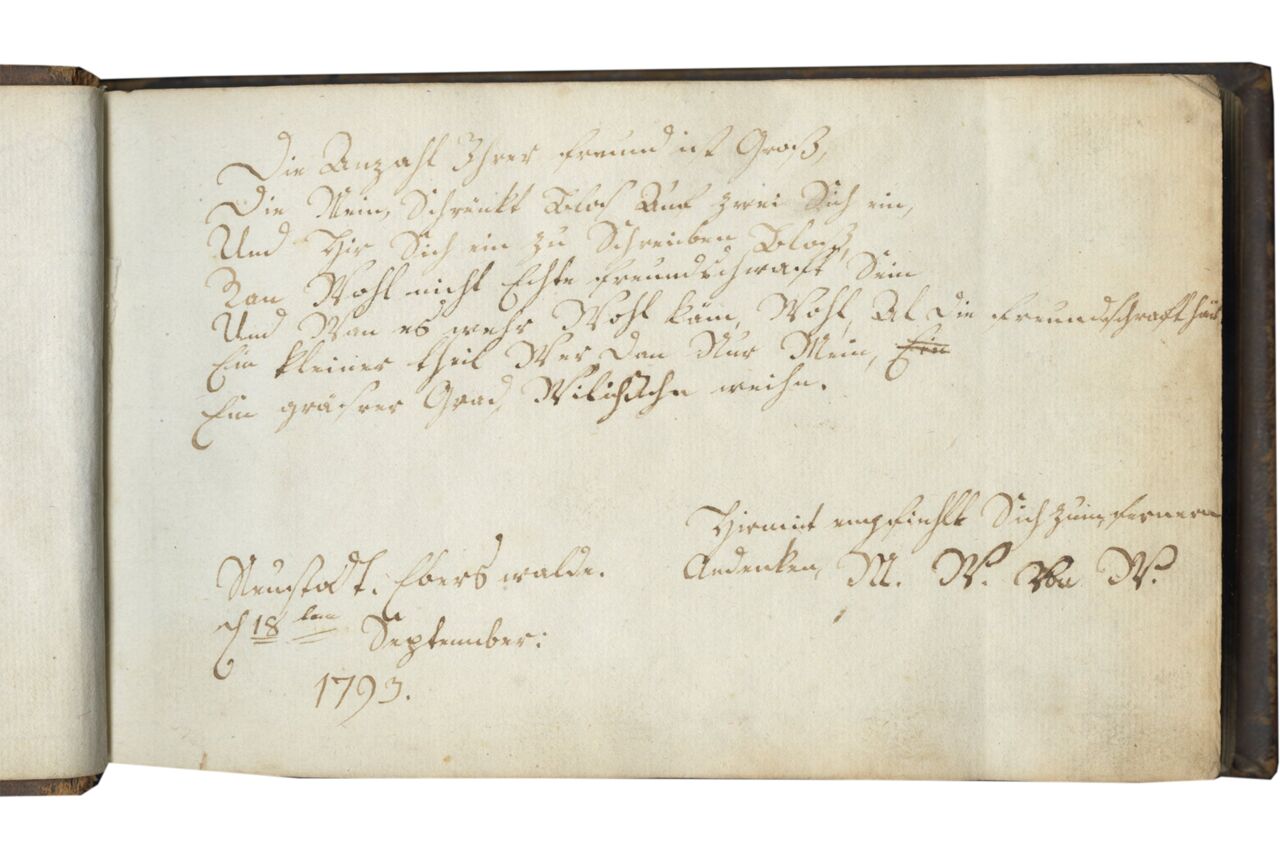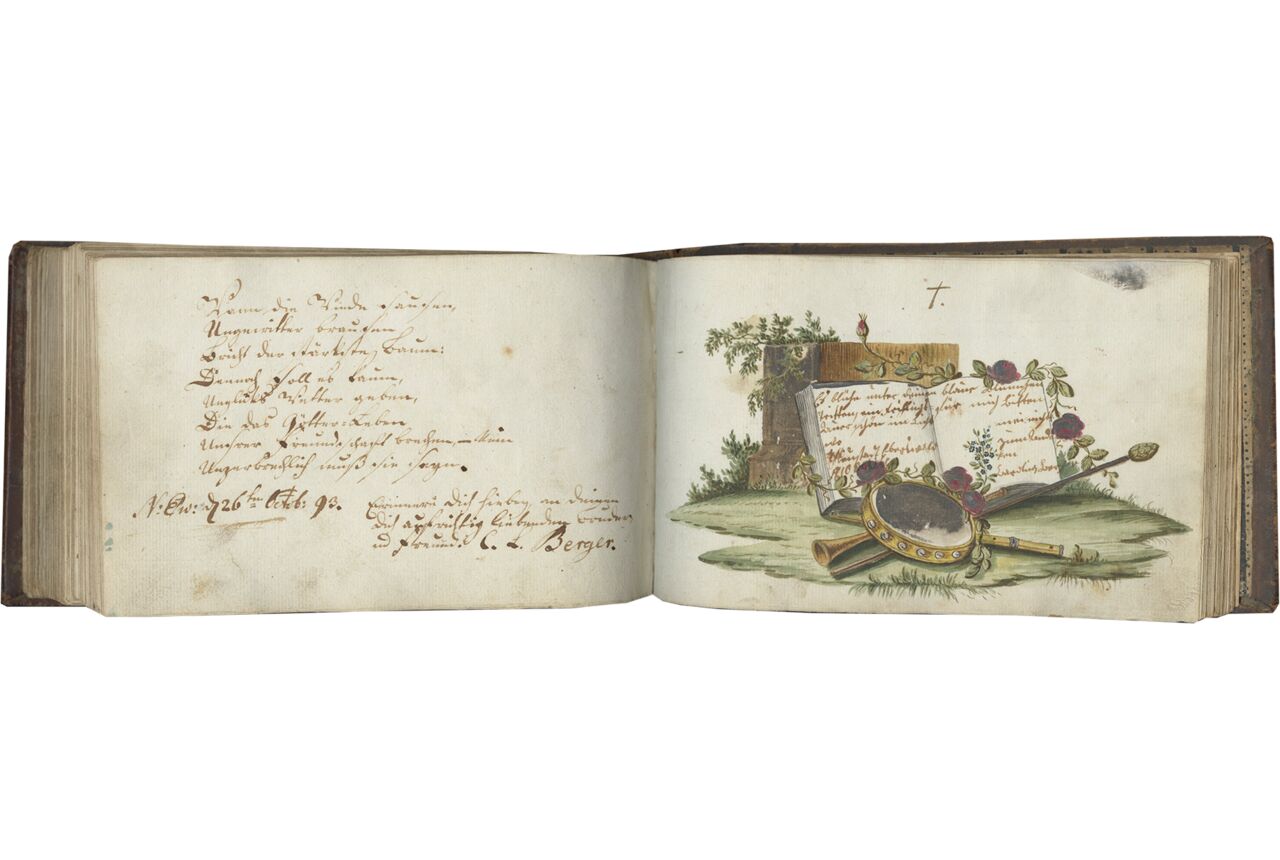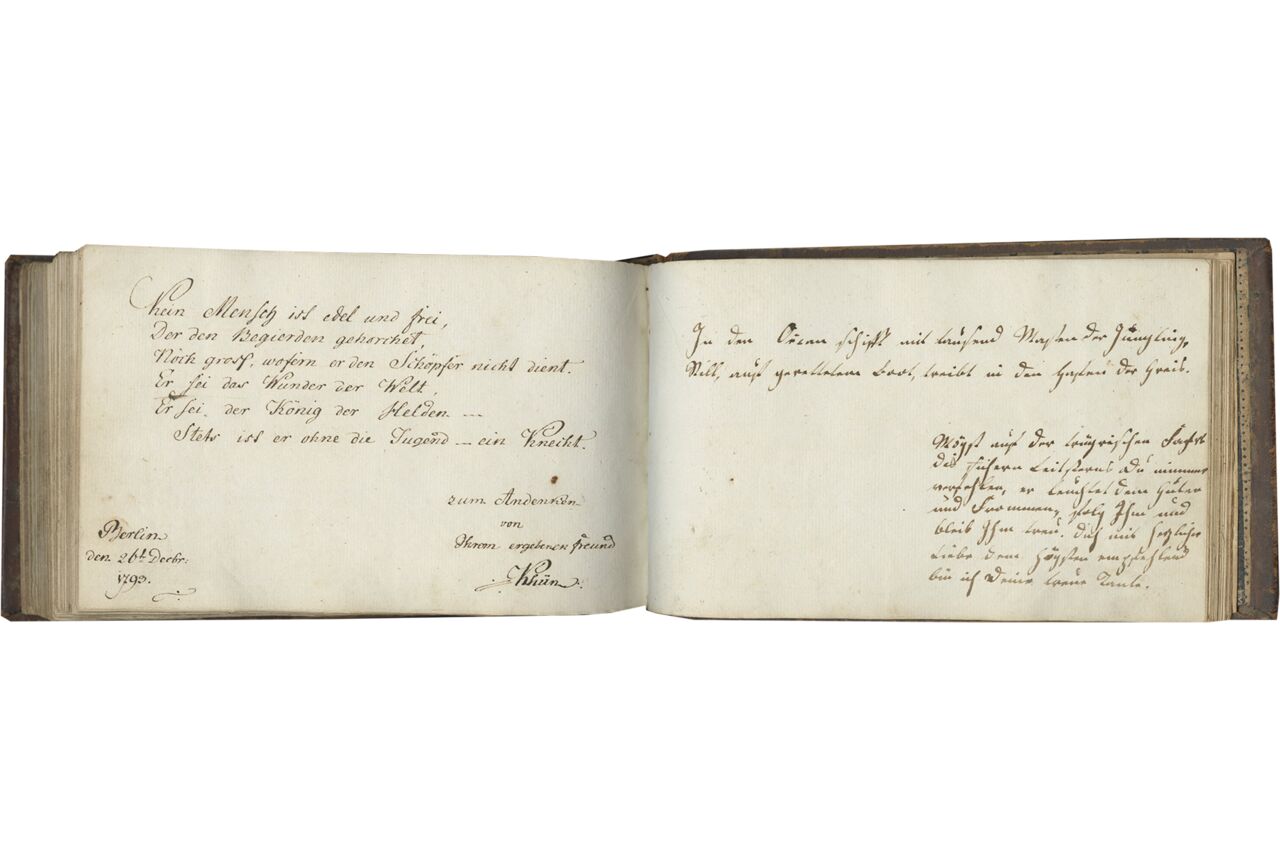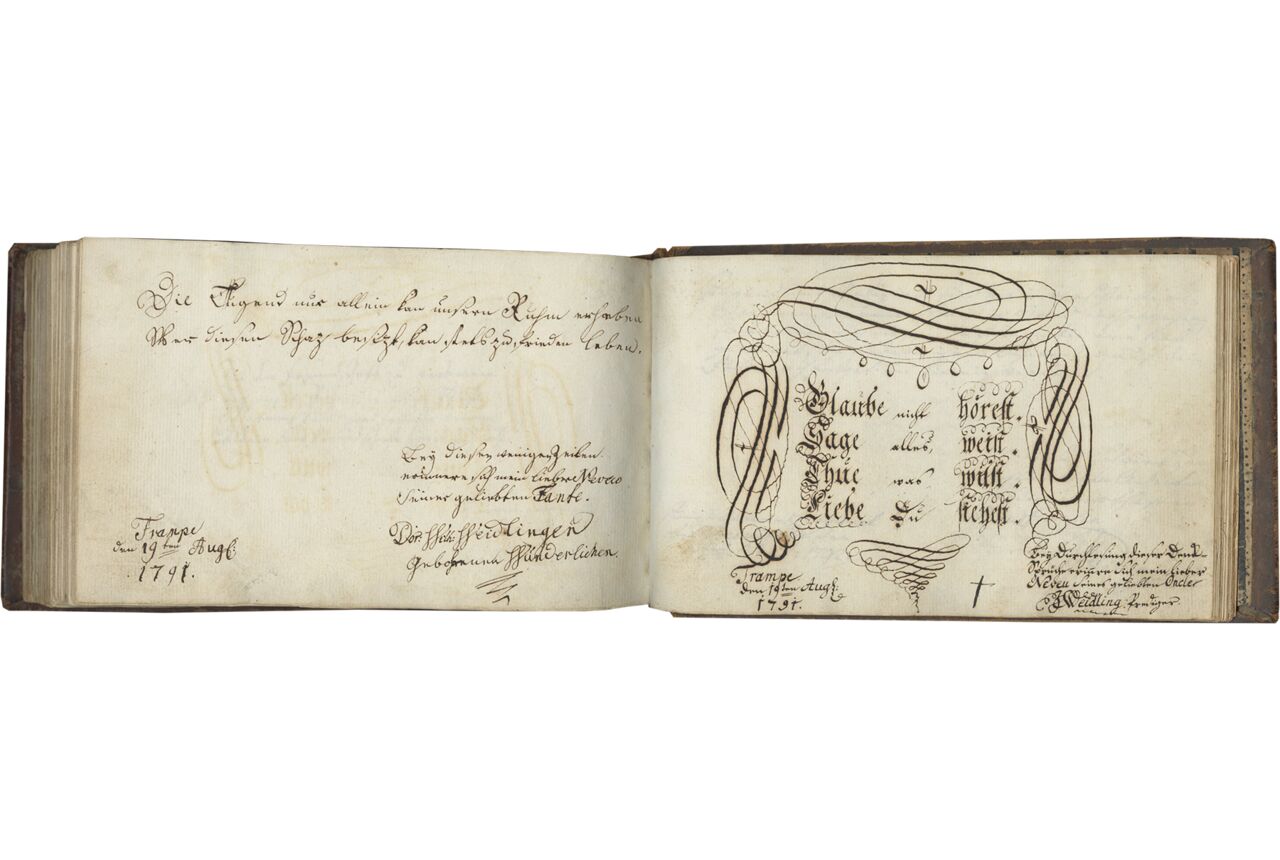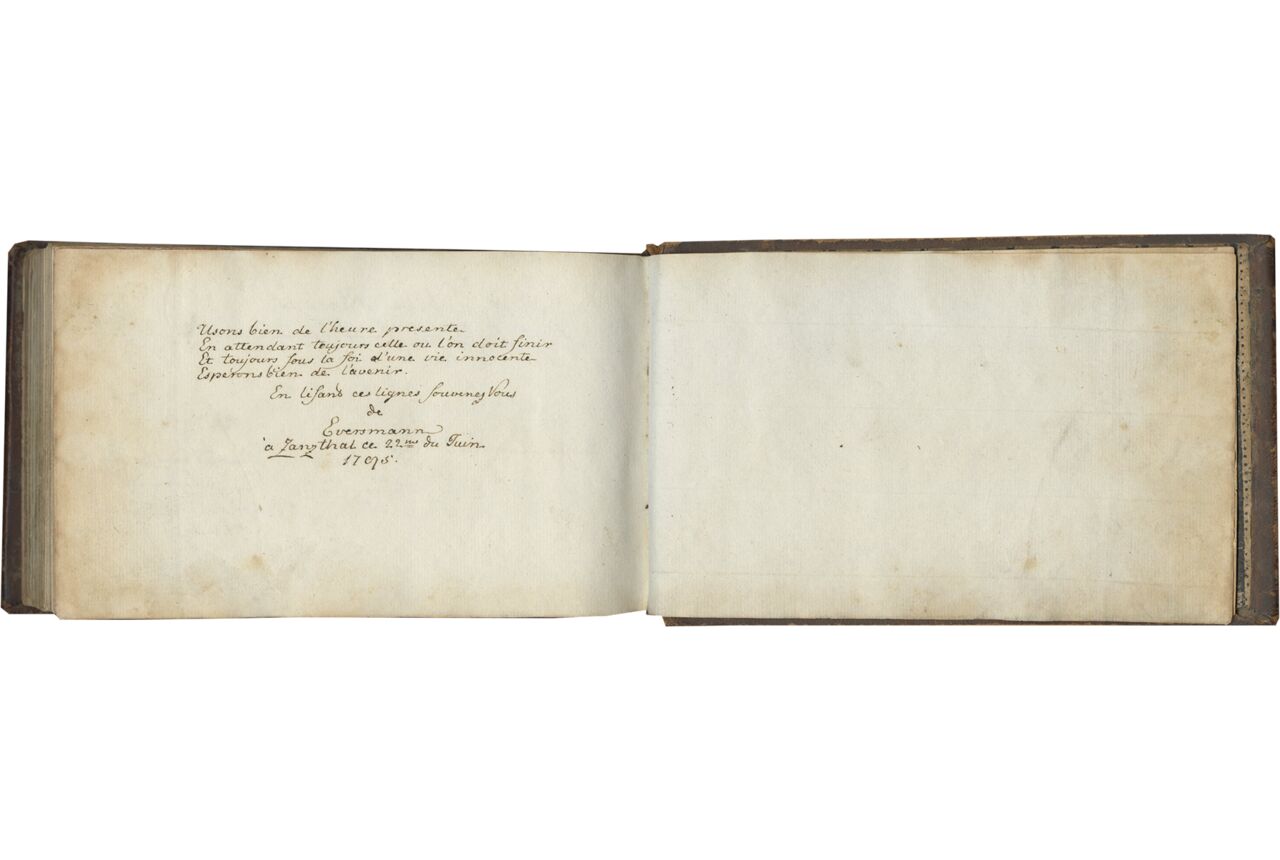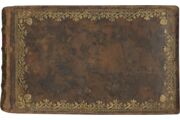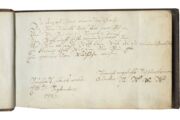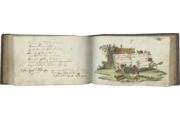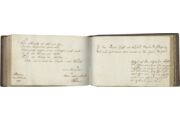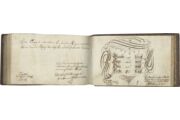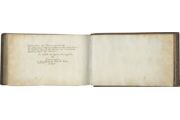i + 159 + i folios on paper, modern foliation in pencil, 1-159, ONE WATERCOLOR, TWO EMBROIDERIES, a black ink stain on f. 130, some other minor stains and signs of use, in overall pristine condition. In its ORIGINAL BINDING of mottled calf over pasteboards, both covers gold-tooled with a frame of delicate foliage, arabesques and corner fleurons, spine with four raised bands, gold-tooled with flowers and leaves, label in red morocco with gilt title “Denkmahl Güter freunde,” gilt edges, painted endleaves and pastedowns, case mottled calf, case and leather on binding worn, but in overall good condition. Dimensions 116 x 185 mm.
This charming Album amicorum has as many as 73 entries by men and women, including two very fine embroideries and a very fine watercolor. The entries were made in different cities in Germany at the turn of the nineteenth century for a member of the Nagell family, probably a woman, as is suggested by the floral embroideries in pastel colors offered by her cousins Caroline and Auguste Philipine Schultz (ff. 83 and 85). Texts include mostly poems in German, but also one in English; the volume concludes with a charming poem in French.
Provenance
1. The album was made for a member of the Nagell family of Karlswerk; see the entries of his/her mother and father on f. 149v (“deine treuer Mütter Nagelln”), f. 150 (“dein treuer Vater Johann Ernst Nagelln”) and f. 150v. The entries,were made in Berlin, Karlswerk, Hohenfinow, Neustadt, Niederfinow, Peitz, Stollenmühl, Stolzenberg, Trampe and Zanzthal during the period of 1791-1813. It was presumably the owner of the album who marked with a cross the entries of friends who had died.
2. Modern bookseller’s note “105” (encircled) on the verso of the front flyleaf.
Illustration
f. 83, Very fine embroidery representing a delicate stem of pink and white flowers, accompanied by a poem in German, signed Auguste Philipine Schultz in Carlswerck on 28 March 1801;
f. 85, Very fine embroidery representing two delicate flower crowns, one with roses, another with white forget-me-nots, accompanied by a short two-line poem, signed Caroline Schultz in Stollenmühl on 1 August 1798; she made another entry on the facing page, f. 84v, in Carlswerck on 24 May 1801;
f. 130, Very fine watercolor representing an open book leaning onto a gravestone; a tambourine, a horn, a flute and a staff(?) are placed in the foreground; a rose vine envelopes the book and instruments; on the leaves of the open book is a poem (perhaps ending with the name Ludwig Levy) and a branch of forget-me-nots ; the entry on the facing page written by the same hand and with same brown ink is signed by C. L. Berger on 26 October (17)93.
Text
Other entries, mainly poems in German, are by M. V. Von V. (f. 2), Justine ... (?) (f. 37v), Luisa Lar... (?) (f. 38), J. F. W. Wittich, “Corporal von der Artill(erie)”, poem in Latin dated on 6 May 1794 in Berlin (probably related to Karl August von Wittich (1772-1831), Prussian Major General, and his son, Ludwig von Wittich (1818-1884), lieutenant general (f. 50), L. V. Gy...(?), friend and cousin (f. 54), Boellner (f. 55v), (?) (f. 56), Caroline Schlesicke (f. 57v), Lah...(?) (f. 58r-v), (?) (f. 67v), J. L. Resagin (?) (f. 68), Carolinna Kang (f. 68v), Charlotte Schnetter (f. 72v), (?) (f. 73), Johane Schulz (f. 74), F. Wilmsen (f. 77), D. P. Froschel (f. 80), G. F. D. Fiedler (?) (f. 82), J. V. Mächern H... Frilzen (f. 86v), Frilze (f. 87), Wilhelm Schiller (?) (f. 88), Caroline Schnebber (f. 89), Charlotta Lahmann (f. 90v), Wilhelmina Lalhe...(?) (f. 91), Augusta Vihülz (?) (f. 92), (?) (f. 93v), W. Schriffer (f. 94), Schula (?) (f. 95), Wraenne (?) (f. 95v), Caroline Koepper (f. 96), Wraeppen (?) (f. 96v), Caroline Schultz (f. 97), H. E. U. (?) (98v), H. M. Schwan (f. 100v), S. S. T. Caltor (f. 101), Walter Linder (f. 102), Luise Schultz (f. 104), C. Kreyher (f. 106), (?) (f. 109), V. Hoffmann (f. 109v), C. F. Bremens (f. 110), M. A. Goldensteedt (f. 111), Anita (?) (f. 115), Lindemann (ff. 117v-118), Hoffmann (f. 119v), Wilhelm Thamerns, “advocat” (f. 126), Charlotta (?) (f. 131v), Wilhelmina Tourbier (f. 132v), Alberte Schlehicke (f. 133), Sophie Beugelin (f. 134), Schoeppen (f. 136), (?) (f. 138), Khün (f. 141v), (?) (f. 142), C. T. (f. 144v), Dor: Wilh: Weidlingen (f. 145v), a poem entered in elaborate calligraphy and creating a fine visual impact on the page by C. Weidling (f. 146), cousin (?)...mann (f. 147), Nagelln (f. 149v), Johann Ernst Nagell (f. 150), (?) ... Nagelln (f. 150v), L. (?) Wärdlingen (f. 151v), Caroline (?) (f. 152v), (?) (f. 153), (?)...saft (f. 153v), Krause (f. 154), Mäldey (?) (f. 154v), Aerckel (?) (f. 155v), (?) (f. 157) and Eversmann (f. 158v).
Among the entries, which are almost exclusively in German, there is one poem entered on f. 111 in English by M. A. Goldensteedt, dated in Berlin on 5 May 1794: “Live happy Friend, thy cares forgo/ all earth born cares are wrong;/ Man wants but little here below,/ nor wants that little long.”
There is also one poem in Latin entered by the general of artillery, J. F. W. Wittich (f. 50), and the volume ends on f. 158v with a poem in French provided by Eversmann, who signed in Zanzthal on 22 June 1795 with these words “En lisans ces lignes souvenez Vous de Eversmann.” His poem reads as follows: “Usons bien de l’heure presente/ En attendant toujours celle ou l’on doit finir/ Et toujours sous la foi d’une vie innocente/ Esperons bien de l’avenir.”
The album amicorum, or album of friends, is a booklet in which the owner collected entries made by their friends and relatives, usually offer poems, wishes, drawings and watercolors, signed with a date and location. The album amicorum was popular from the sixteenth until the nineteenth century. It was initially favored by men in aristocratic, bourgeois and university circles, and entries were collected from acquaintances met during travels and studies. However, at the beginning of the nineteenth century, the albums were increasingly made for women. The entries made in our manuscript are by men and women. The album amicorum is central in modern transdisciplinary research studying texts, reception and collecting in cultural and social contexts and the history of mentalities; see especially the comprehensive study by Werner Wilhelm Schnabel published in 2003. Albums for women have generally been less studied than have those for men (see Reinders, 2016 and 2017, studying early examples of albums for women).
Literature
Fechner, J.-U., ed. Stammbücher als kulturhistorische Quellen, Wolfenbütteler Forschungen, 11, Munich, 1981.
Keil, R. and R. Die deutschen Stammbücher des sechzehnten bis neunzehnten Jahrhunderts. Ernst und Scherz, Weisheit und Schwank in Original-Mittheilungen zur deutschen Kultur-Geschichte, Berlin, 1893 (reprint Hildesheim, 1975).
Klose, W. “Stammbücher: eine kulturhistorische Betrachtung,” Bibliothek und Wissenschaft 16 (1982), pp. 41-67.
Kurras, L. Zu gutem Gedenken. Kulturhistorische Miniaturen aus Stammbüchern des Germanischen Nationalmuseums 1570-1770, Munich, 1987.
Lilienthal, M. Schediasma critico-literarium de philiothecis varioque earundum usu et abusu, vulgo von Stamm-Büchern, Königsberg, 1712; rev. Wittenberg, 1740 (repr. in Fechner, 1981, pp. 237-298). [the first study of Alba Amicorum].
Nickson, M.A.E. Early Autograph Albums in the British Museum, London, Trustees of the British Museum, 1970.
Reinders, Sophie. De mug en de kaars. Vriendenboekies van adellijke vrouwen, 1575-1640, Nijmgen, 2017.
(Summary of her dissertation (English) https://www.academia.edu/35402416/Summary_docx)
Reinders, Sophie. “Social Networking is in Our DNA: Women’s Alba Amicorum as Places to Build and Affirm Group Identities,” in Dieuwke Van Der Poel, Louis P. Grijp, and Wim van Anrooij, eds., Identity, Intertextuality, and Performance in Early Modern Song Culture, Leiden, 2016, p. 150-177.
https://brill.com/display/book/9789004314986/B9789004314986_007.xml
Rosenheim, M. The album amicorum, Oxford, 1910.
Schnabel, W. W. Das Stammbuch: Konstitution und Geschichte einer textsortenbezogenen Sammelform bis ins erste Drittel des 18. Jahrhunderts, Berlin, 2003.
Schünemann, H. “Stammbücher,” Schrifttumsberichte zur Genealogie und zu ihren Nachbargebieten 2 (1965), pp. 67-108.
Taegert, W. Edler Schatzholden Erinnerns: Bilder in Stammbüchern der Staatsbibliothek Bamberg aus vier Jahrhunderten, Bamberg, 1995.
Thomassen, K., ed. Alba amicorum. Vijf eeuwen vriendscap op papier gezet. Het album amicorum en het poëziealbum in de Nederlanden, Maarssen/The Hague, 1990.
Online Resources
Repertorium Alborum Amicorum
https://raa.gf-franken.de/de/startseite.html
Our manuscript:
https://raa.gf-franken.de/de/suche-nach-stammbuechern.html?permaLink=1791_nagel
TM 1245


